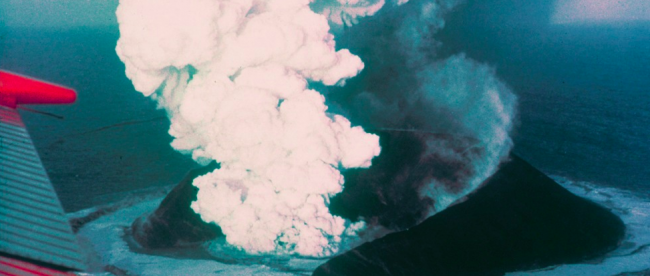The Tomato Plant Versus the Volcano

In 1990, the New York Times called Surtsey the “Youngest Spot on Earth.” That’s probably accurate. Surtsey is part of Iceland; it’s a tiny volcanic island just a few miles south of the Icelandic mainland. And it didn’t exist before 1963. It was born, let’s say, in November of that year when a submarine volcano erupted. After the volcano went dormant in the summer of 1967, Surtsey began eroding back into the sea; today, it’s only about half a square mile in total area, and at some point, Surtsey will likely disappear entirely.
But for the time being, it’s there. And it provides scientists with a unique opportunity: the tiny island is as pristine an ecosystem as it gets. Because nothing was on the island when it first formed — no flora, no fauna, just rock — it is perhaps the only place on Earth where we get to see the local ecology develop from the beginning. And just as importantly, it is one of the few places where people haven’t significantly interfered with the local ecology. So when researchers go to observe the changes to the island, every discovery — even down to a single fly buzzing around — is cause for further investigation.
To keep it that way, there are rules for us humans. You don’t go there, except for some very restrictive exceptions for researchers and journalists — tourism is strictly forbidden. Ther only accommodations are a small hut with a few bunk beds and limited electricity (powered by a solar panel) for emergency use only. And visitors are held to a very high standard of care. Before they helicopter over to the island, they are checked and double-checked for seeds. Even an errant one — a sunflower seed in your bottom of your backpack, maybe — could find itself embedded in the nutrient-rich volcanic soil and turn into a plant, which would spoil the scientific value of Surtsey’s ecosystem.
And yet, in 1977, the research team found something which shouldn’t have been there. As plant ecologist Borgthór Magnússon recounted to the Christian Science Monitor in 2008, the team “came across some strange plants growing in the sand around the hut and we were excited because it was unusual to find plants so lush and so many.” Magnússon and company determined that potatoes were growing on the island — and that wasn’t something that should have occurred naturally: “It was obvious they had not been washed ashore by the sea, they had been planted deliberately in the sand.” It turned out that some pranksters from a nearby island rowed ashore to Surtsey and planted some leftover potatoes.
That wasn’t the first time Surtsey had been spoiled a bit, though. A few years earlier, researchers found another too-mature plant on the island as well — but in this case, how it got there was an accident. Ágúst Bjarnason, another member of the research team, found something out of place back in 1969. He told the Icelandic Review his story: “I bent down and rolled two lava rocks aside which lay against the plant on either side. Underneath was a peculiar pile which was very soft when I poked it. Suddenly it dawned on me what it was. Someone had done their business [there] … and this beautiful tomato plant (Solanum lycopersicum), 15-cm [5-in] tall, had grown out of the faeces.” Apparently, during the seed check and double-check, no one had inspected the recent diets (or stomach contents) of the visitors.
In both cases, the errant plants were removed once discovered, keeping the rest of the environment untarnished. In the case of the tomatoes, those overseeing the researcher added another rule to the list: be mindful of where you poop, and when in doubt, take it back with you.
Bonus fact: Iceland isn’t a tropical paradise — far from it, literally and figuratively. And yet, for much of the 1940s and into the 1950s, the small island nation had a thriving banana industry. Duties on fruit made importing bananas too costly, so they just grew their own — an effort made possible by ubiquitous geothermal energy and greenhouses. But the bananas took very long to reach maturity — two years compared to a few months for those grown in the tropics, per Wikipedia. As a result, when the country removed the import duties in 1960, the Icelandic banana industry disappeared.
From the Archives: Jólabókaflóð: Why you’ll likely get a book if you celebrate Christmas in Iceland.
